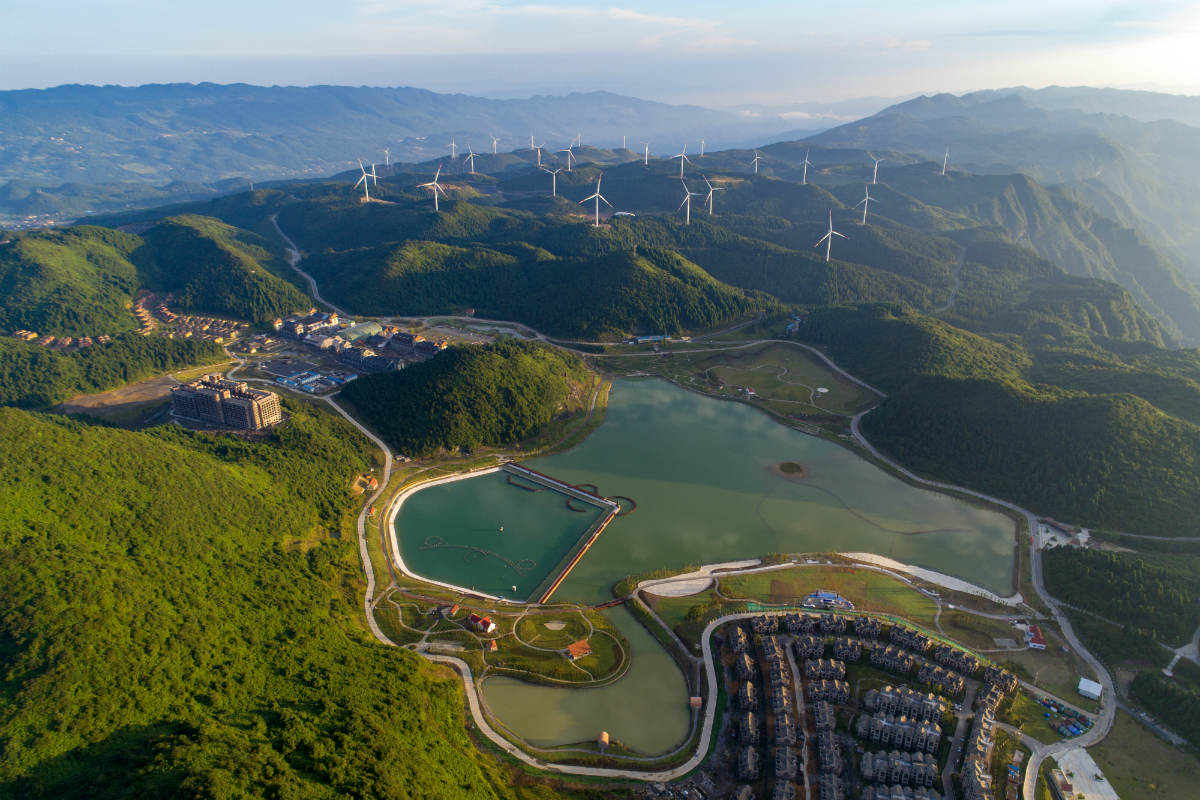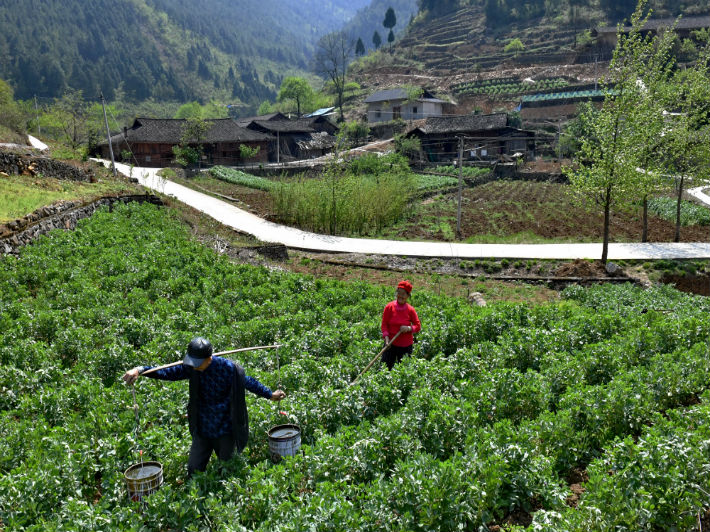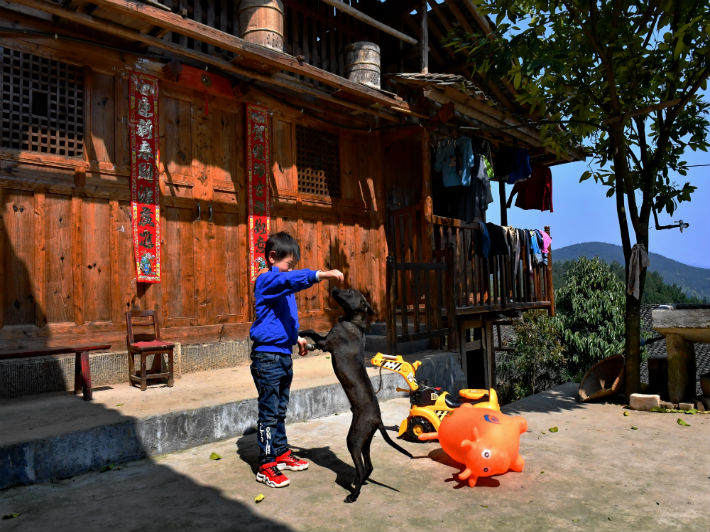Green Poverty Reduction

Fengdu County, which prospered along the upper reaches of the Yangtze River, is located in the geographical center of Chongqing Municipality and the central part of the Three Gorges Reservoir area. Boasting a history of more than 1,900 years, the county is covered by rolling mountains with lush greenery that can be seen from afar. The Yangtze River runs through Fengdu for 47 kilometers, connecting to 55 tributaries there. “No extensive development will be allowed, and all protection efforts must be highly coordinated,” stressed Chinese President Xi Jinping on the development strategy for the Yangtze River Economic Belt. As a county situated on the upper reaches of the Yangtze River, Fengdu considers ecological and environmental protection its solemn duty.
Meanwhile, Fengdu was once a national poverty-stricken county. As early as 2002, it was identified as a key county for poverty alleviation and development. In 2011, it became a pilot county for poverty reduction and development in the Wuling Mountains area, one of the 14 contiguous poverty-stricken areas in China. By the end of 2014, it was home to 19,400 poverty-stricken households of 71,917 people living in 95 impoverished villages. The poverty incidence was 12.1 percent. Thus, Fengdu has been attaching equal importance to Yangtze River protection and poverty reduction over the past few years. In November 2017, Fengdu overcame the title of national poverty-stricken county and its poverty incidence is now 0.67 percent. The county has showed wisdom and gained experience solving problems of environmental protection and social development at the same time.
Two Battles at Once
Clear waters and lush mountains are invaluable assets. Fengdu people understand that “no extensive development, only highly coordinated protection” isn’t about giving up economic development for the sake of protecting the environment. It is more about balancing the relationship between development and protection and developing according to local conditions while maintaining the ecological environment of the Yangtze River.

An elderly couple works in a field in Jinzhulin Village, Fengdu County. The economic development brought about by China’s nationwide poverty alleviation efforts is revitalizing the small village. by Yu Xiangjun
Thus, Fengdu formulated and implemented a strategy of “putting ecology first and promoting green development.” It resolutely seeks green and high-quality development with a priority on ecological protection. The county has made its development strategy crystal-clear and insisted on making plans first. Right now, it is carrying forward the productivity distribution plan featuring “one core, two poles and three belts.”
“One core” refers to the development of urban economic drivers including ecological industry, commerce and trade with the planned area in the county seat as the core and avoiding a decentralized industrial layout that may affect the environment. “Two poles” are the two economic growth poles: tourism development in the south and agricultural development in the north on opposite banks of the Yangtze River. This piece of the strategy aims to avoid disorderly and destructive exploitation. “Three belts” are the three ecological economic belts respectively along the Yangtze River, the Quxi and Bixi rivers, and the Longhe River. With efforts to preserve clear waters and green mountains, this move aims to place high-efficiency planting industries in the drainage basin’s rain collection areas.
Under the government’s top-level design, Fengdu has formed an industrial chain around its unique features with focus on beef cattle ranching. Green industries such as tourism, red pomelo production, and bamboo shoot cultivation and processing have also begun to take shape, which have helped facilitate the rise of impoverished households out of poverty.
Green Development of a Pillar Industry
On the way to Fengdu’s Gaojia Town, banners advertising “China’s Beef Capital” were waving in the breeze. In recent years, Fengdu’s beef industry has been quietly booming. “Fengdu Beef” has been designated as a national well-known trademark by China’s State Administration for Market Regulation. At present, the county is sparing no efforts to truly embrace the title of “China’s Beef Capital.”
In 2018, about 6,100 poverty-stricken households in Fengdu were involved in cattle ranching. Through the industry, many have risen from poverty.
Guided by green development concepts, Fengdu built its beef industry while adhering to ecological breeding. The county was divided into three zones where cattle ranching is respectively prohibited, restricted and permitted. Organic and non-hazardous treatment of dung has been introduced. Fengdu’s beef industry attaches great importance to ecological conservation.
Located in Gaojia Town, Hondo Beef Cattle Farm was established in 2011. It is the largest single ranch in China today, holding as many as 15,000 cattle at a time. Hondo has established a comprehensive set of management methods to treat dung and prevent pollution: The farm adopted an environmentally friendly treatment mode featuring a circular economy including diversion of rain and sewage, biogas power generation, standardized processing before discharge and oxidation reduction. Large-scale breeding of beef cattle has realized green development.
Not far from the farm is Chongqing Fengzeyuan Fertilizers Co., Ltd., the largest organic fertilizer plant in southwestern China featuring standardized production. Cattle dung from Hondo is directly transported to the plant through pipelines. After fermentation, feces are transformed into organic fertilizers.
“Harmless treatment and recycled utilization of agricultural waste are fundamental to green development,” declared Wu Dongping, deputy general manager of Fengzeyuan Fertilizers Co., Ltd. The company now cooperates with the Nanjing-based Institute of Soil Science under the Chinese Academy of Sciences. In Fengzeyuan, chicken manure, cattle excrement and residue from mushroom production are mixed with used Chinese medicinal herbs and fermented for 24 hours. The mixture becomes organic fertilizer which can be used for agriculture. This is a key way that recycled utilization of resources and green development are realized. Alongside Hondo, other large ranchers in Fengdu also send their cattle excrement to Fengzeyuan for treatment. Cattle dung, which used to be worthless, now sells for 90 yuan (US$13) a ton. And the price is going up.
Today, Fengdu is still working feverishly to become the national pilot county for comprehensive utilization of agricultural waste. The current rate of cattle manure treatment and resource utilization has reached 80 percent.
Tourism Facilitates Poverty Reduction
Topographically, Fengdu is dominated by mountainous landforms and rolling hills. Narrow strips of flatland are only found in valleys at altitudes ranging from 175 meters up to 2,000 meters.

Five-year-old Tian Haoyang plays in front of his home in Jinzhulin Village, Fengdu County. The house, after renovation by Tian’s father engaged in business, has become one of the few new houses in the village. by Yan Xiangjun
An ancient city with a time-honored history and a reputation as the “Ghost City” among Chinese people, Fengdu boasts rich tourism resources. Mingshan Mountain in Fengdu, a national-level scenic spot, is usually the first stop for tourists visiting the Three Gorges along the Yangtze River. To further develop its tourism, expand its tourism industrial chain and capitalize on its clear rivers and green mountains, Fengdu is focused on building a tourism industry covering the whole county.
At the Jiuchongtian scenic spot at an elevation of more than 1,000 meters, a suspended glass bridge across the deep valley is hidden in clouds. The scenic spot officially opened in July 2017 as another national 4A scenic resort in Fengdu.
Lianhuadong Village in Shuanglu Township, where the Jiuchongtian scenic spot is located, was once a county-level impoverished village. “Now, villagers develop their own agritainment businesses, sell agricultural products or just work in the scenic spot,” explained Chen Guohai, an investor in the Jiuchongtian scenic spot. Locals can also invest in the scenic spot with land. The scenic spot pays rent to the villagers at a rate of 400 yuan (US$58) per mu (0.067 hectare) of land and 100 yuan (US$14.5) per mu of forest in the first four years after the land transfer. This guarantees income from villagers’ investments in the form of land. Starting in the fifth year, villagers will receive dividends from the scenic spot, accounting for 20 percent of its total ticket revenues.
Today, Fengdu is home to four national 4A scenic resorts including Mingshan Mountain, Xueyu Karst Cave, Nantian Lake and Jiuchongtian. In 2014, “Fengdu Temple Fair” was added to the list of China’s National Intangible Cultural Heritage. The tourism industry throughout the county has become a new calling card for Fengdu. A picturesque scroll of “green mountains along the Yangtze River” is slowly unfolding before the eyes of Fengdu people.
Since the 18th National Congress of the Communist Party of China in 2012, China’s has amazed the world with its impressive poverty reduction. According to China’s current standards, the country’s rural poverty-stricken population dropped from nearly 99 million in 2012 to 16.6 million in 2018. Poverty, a problem that has plagued the country for thousands of years, has now reached its final stretch before total elimination. The nearer the end gets, the harder the journey becomes. In Fengdu today live 3,948 impoverished people in 1,440 households across four poverty-stricken townships and 28 poverty-stricken villages. The fight against poverty in Fengdu is still raging, and the final stage has yet to come.